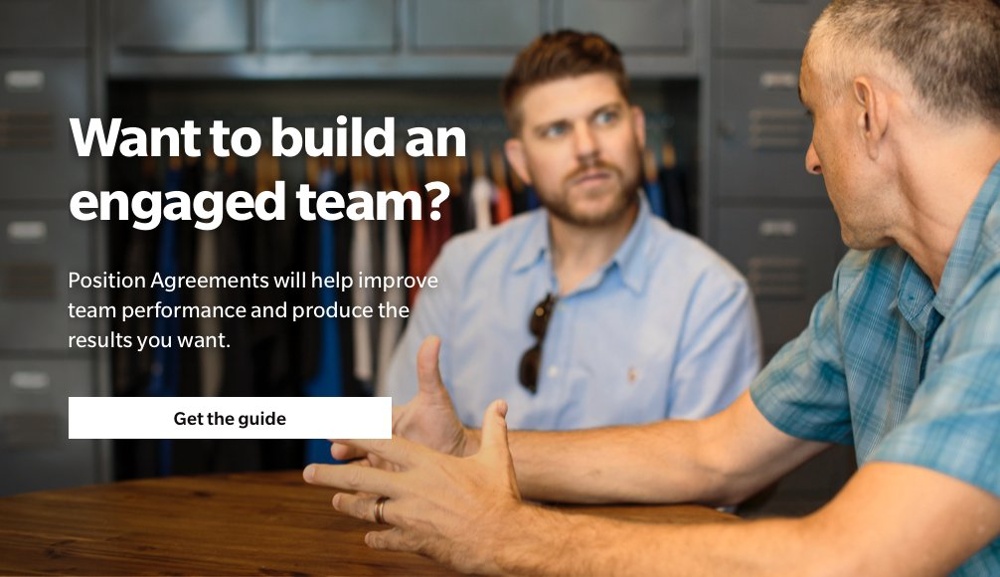How do you create a company that produces consistent and desirable results—no matter what? It’s a question every business owner asks, and the answer is simple: Create systems that support the outcomes you want to achieve—from the customer experience and team culture you want to promote, to the product you deliver and your annual revenue goals.
But while the answer is simple, the process requires you to create structure across all areas of the business. So how do you do that?
A great place to start is with an organizational chart—your strategic management structure that includes all the positions needed to support your results.
But once you have that, you need to make sure every employee who fills a position on that chart knows exactly what they’re responsible for achieving. That’s where the Position Agreement (also known as Position Contracts) comes in. It defines how each position within your organizational chart connects to your overall company outcomes, helping you and your employees grow the business with focus and confidence.
Here’s what you need to know about Position Agreements and how they bring value to both your employees and your entire organization.
A Position Agreement is not a job description
Job descriptions are fundamental to the hiring process. As an owner, you’ve likely written them for many areas of your business, creating clear, nuts-and-bolts lists of the capabilities required for each role so you get the best possible applicants. A job description is useful as an external tool—but when working to build a results-driven team, you need something that focuses on the outcomes each position is responsible for and how to achieve them.
A Position Agreement is designed around results statements. It’s a tool for use within your team—an agreement between a manager and the employee responsible for accomplishing certain results—to encourage collaboration focused on outcome rather than assigning to-do lists. This is a key difference, and it makes Position Agreements incredibly effective. As your company grows and changes, the results you want to achieve may stay very much the same, while the means to achieve those results will change.
Position Agreements offer structured freedom. By defining the expected results of each position and the standards needed to achieve them—instead of simply assigning a task list—you’re giving your employees a framework and the means to be flexible, innovative and creative around how the work gets done.
This subtle shift in thinking has a deep effect. It always keeps the results a priority and directs managers to create the environments needed for each person to achieve the expectations outlined in their position or positions.
Position Agreements boost individual productivity
In order to stay focused on producing results, your employees need to know where they fit into the company structure. Position Agreements create this clarity, showing how each position fits into your company vision, organizational strategy and systems. If your employees can see how their work is connected to something bigger and have a more high-level picture of why they’re a part of the team, they’ll have context to know what work is theirs to do and what they should say no to. This way, when a new task arises, they can ask themselves:
Is this work part of my job?
Is this connected to what I can do within my role?
Knowing how responsibilities fit into the bigger picture helps employees concentrate and avoid distraction. More importantly, it empowers them to manage their own work—and their own success.
Position Agreements improve teamwork
Clarity of work at the employee level also radiates out to the team. Often in teams, there’s overlap between positions. Team members can have the same skill sets, be trained on the same things, perform similar tasks, but each of them (and this is key) could have different result statements. Creating results-based guidelines for each position allows a team to consider everyone’s individual accountability and helps them avoid creating “double-work” (having several team members doing the same things unnecessarily). It puts responsibility on the entire team to answer:
Who’s really responsible for this result?
Does it make sense for this person to hold this in their role?
This transparency fosters collaboration because it allows each employee to ask—and answer together—where things should really live within the organization.
Position Agreements help you delegate (and keep employees focused on their roles)
In our recent blog, “How to build a business partnership that works,” we discussed the importance of you—the owner—staying in your lane to do the work of your job, and not that of your partner(s). The same is true for employees.
Clear Position Agreements—with clear results statements—help your people do that, and they help you look at the landscape of your company and consider how every employee’s position fits into it. When you have work that needs to be delegated, a clear Position Agreement lets you consider an employee and ask:
Does it make sense to give this work to them?
Is this their role?
Does it relate to the results they needs to accomplish?
Does this position need to be changed to include this new work?
Being able to answer and designate responsibilities based on these questions (rather than on who has more time or bandwidth to get the work done) maintains the integrity of your organizational structure and positions, keeping everyone on track to meet your company-wide goals.
If you’re challenged to create an organizational chart or Position Agreements and want to know more about how EMyth Coaching can help, schedule a Free Coaching Session.




Comments